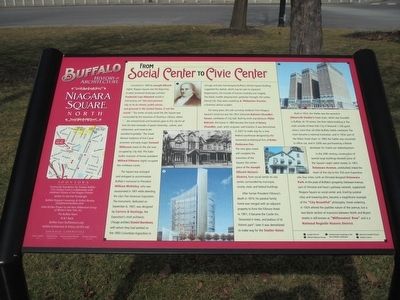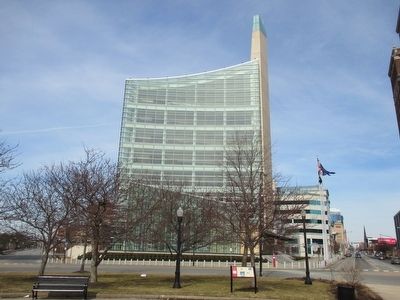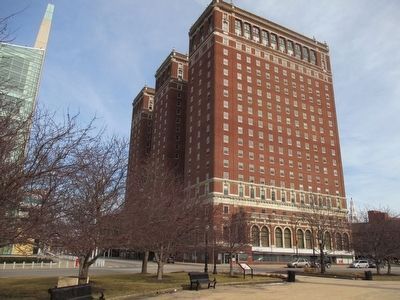Downtown in Buffalo in Erie County, New York — The American Northeast (Mid-Atlantic)
From Social Center to Civic Center
Buffalo History and Architecture
— Niagara Square North —
Inscription.
Conceived in 1804 by Joseph Ellicott (right), Niagara Square was the beginning of what renowned landscape architect Frederick Law Olmsted would in mid-century call "the best planned city as to its streets, public places, and grounds in the United States, if not the world." The center of early social life, the Square was surrounded by the mansions of illustrious citizens, where "...the revered hosts and hostesses gave to this city for all time the best examples of good citizenship, culture, and refinement, and never-to-be-excelled hospitality." The Greek Revival residence of Erie Canal promoter and early mayor Samuel Wilkeson stood on the site now occupied by City Hall. The Tudor Gothic mansion of former president Millard Fillmore (right) occupied the northeast corner.
The Square was enlarged and reshaped to accomodate Buffalo's memorial to President William McKinley, who was assassinated in 1901 while attending the city's Pan-American Exposition. The monument, dedicated on September 6, 1907, was designed by Carrere & Hastings, the Exposition's chief architects. Chicago architect Daniel Burnham, with whom they had worked on the 1893 Columbian Exposition in Chicago and who designed Buffalo's Ellicott Square Building, suggested the obelisk, which may be seen to represent Regeneration, the triumph of human creativity over tragedy. The Italian marble sleeping lions symbolize Strength; the turtles, Eternal Life. They were created by A. Philmister Proctor.
For many years, the sole surviving residence from Niagara Square's social era was the 1852 Italianate Balcom-Chandler house, northwest of City Hall. Built by brick manufacturer Philo Balcom, the house in 1865 became the home of Henry Chandler, poet, artist, engraver, and inventor. It was demolished in 2007 to make way for a new federal courthouse designed by the renowned architectural firm of Kohn Pederson Fox. The new glass tower will complete the transition of the Square, the center-piece of the Joseph Ellicott Historic District, from social center to civic center, surrounded by municipal, county, state, and federal buildings.
After former President Fillmore's death in 1987, his palatial family home was merged with an adjacent property to form the Fillmore Hotel. In 1901, it became the Castle Inn, "bosomed in trees, and jealous of its historic past"; later it was demolished to make way for the Statler Hotel.
Built in 1923, the Statler was the second in Ellsworth Statler's hotel chain, which was founded in Buffalo. At 19 stories, the then tallest building in the state outside of New York City, it featured 1,100 guest rooms, more than all other Buffalo hotels combined. The chain became a national institution, and in 1954, part of the Hilton Hotel chain. in 1983, the Statler was converted to office use, and in 2006 was purchased by a British developer for mixed-use redevelopment.
In the 20th century, construction of several large buildings blocked some of the Square's eight radial streets. In 1901, Delaware Avenue, undisturbed, linked the heart of the city to the 350-acre Exposition site, four miles north at Olmsted-designed Delaware Park. At the peak of Buffalo's prosperity, Delaware Avenue, part of Olmsted and Vaux's parkway network, supplanted Niagara Square as social center and, lines by palatial villas and towering elms, became a magnificent example of the "City Beautiful" philosophy. Street widening in 1924 altered the parklike nature of the avenue, but a two-block section of mansions between North and Bryant streets is still known as "Millionares' Row" and is a National Register Historic District.
1) Joseph Ellicott
2) Millard Fillmore House
3) Architectural rendering of the new federal courthouse
4) Balcom-Chandler House
5) Statler Towers
Erected by Community Foundation for Greater Buffalo 21st Century Fund in collaboration with Landmark Society of the Niagara Frontier, et al.
Topics and series. This historical marker is listed in this topic list: Architecture. In addition, it is included in the Former U.S. Presidents: #13 Millard Fillmore, and the Former U.S. Presidents: #25 William McKinley series lists. A significant historical year for this entry is 1804.
Location. 42° 53.203′ N, 78° 52.688′ W. Marker is in Buffalo, New York, in Erie County. It is in Downtown. Marker can be reached from the intersection of Niagara Square and Delaware Avenue (New York State Route 384), in the median. Marker is at the north perimeter of the paved walking circle around the McKinley Monument at the center of Niagara Square. The marker faces the monument. Touch for map. Marker is in this post office area: Buffalo NY 14202, United States of America. Touch for directions.
Other nearby markers. At least 8 other markers are within walking distance of this marker. Buffalo Burns!!! (a few steps from this marker); Niagara Square (within shouting distance of this marker); William McKinley (within shouting distance of this marker); From Frontier to Major City / Buffalo City Hall (within shouting distance of this marker); "...With Liberty and Justice for All." (within shouting distance of this marker); Our Legacy of Abundant Water (within shouting distance of this marker); Samuel Manning Welch (about 400 feet away, measured in a direct line); Charles R. Turner (about 500 feet away). Touch for a list and map of all markers in Buffalo.
Related markers. Click here for a list of markers that are related to this marker. Markers with information about Joseph Ellicott, Frederick Law Olmsted and Samuel Wilkeson, followed by the McKinley Monument and the Eillicott Square Building.
Credits. This page was last revised on February 16, 2023. It was originally submitted on March 2, 2016, by Anton Schwarzmueller of Wilson, New York. This page has been viewed 439 times since then and 12 times this year. Photos: 1, 2, 3. submitted on March 2, 2016, by Anton Schwarzmueller of Wilson, New York.


